Real Moms, Real Kids: All About Spelling and Cursive
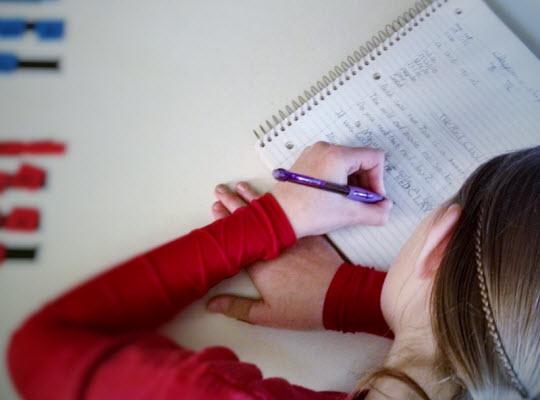
Can you teach spelling and cursive at the very same time?
Lori* is a real mom with two real kids who use All About Spelling. Cursive writing was a skill that Lori’s kids desperately needed to improve, but she was struggling to fit another subject into their school day.
So Lori did what any enterprising mom would do: she figured out a way for spelling lessons to serve double duty.
When she decided to “piggyback” cursive into their AAS lessons, Lori discovered a double benefit. Not only did her children’s cursive writing improve, but they also got in some extra spelling practice! And she was able to check two subjects off her to-do list—with just five extra minutes of work each day. Now that’s good planning!
Would you like to find out how your children can practice cursive in just five extra minutes each day? Read on!
Here’s Lori…
I’m excited to share how I piggyback cursive onto our regular All About Spelling lessons. I am working with two older students: a sixth grader and a dyslexic high school student who really struggled with cursive, especially reading it.
We follow Marie’s advice and spend 20 minutes per day on spelling. I set the timer for 20 minutes, and when the timer goes off, it’s time for cursive practice.
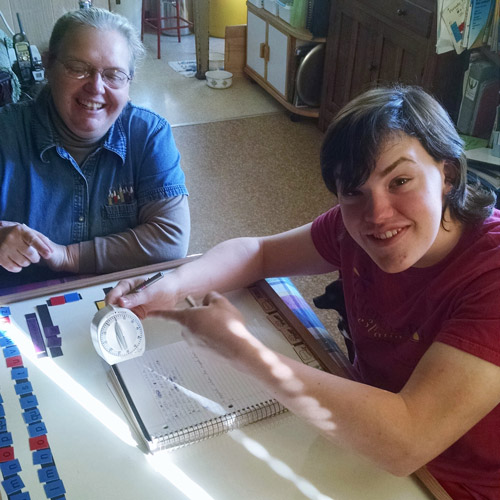
Here is how our cursive practice has progressed over the last year.
At first, I would just ask them to write one sentence using the spelling words they had written in their notebooks. Then they had to copy the sentence in cursive. When that became easier for them, I allowed them to skip the first part and write the sentence directly in cursive.
Here’s the part that was the key. I did the same. Using their words, I wrote a cursive sentence too. Then I had them read my sentence two or three times for fluency. As the year progressed, the difficulty progressed. At first I wrote my sentences on the white board in large, careful letters.
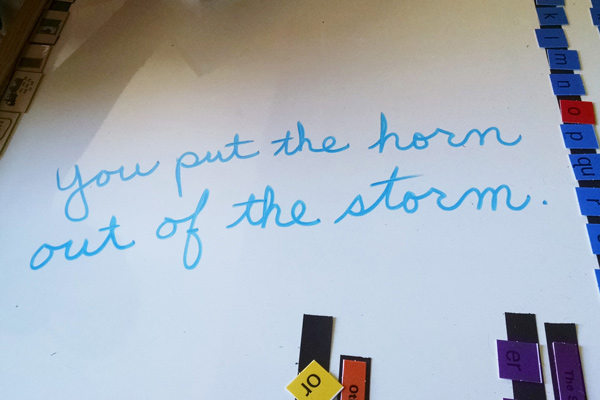
Gradually, I transitioned to smaller letters. Then I moved to lined paper, writing on every other line with very carefully formed cursive. Now they are reading sentences on every line, written more normally—meaning less carefully.
We are now writing two sentences at a time. At first I allowed them to write any two sentences. Now the sentences have to be related—a tiny story—but always using the spelling words they have studied that day.
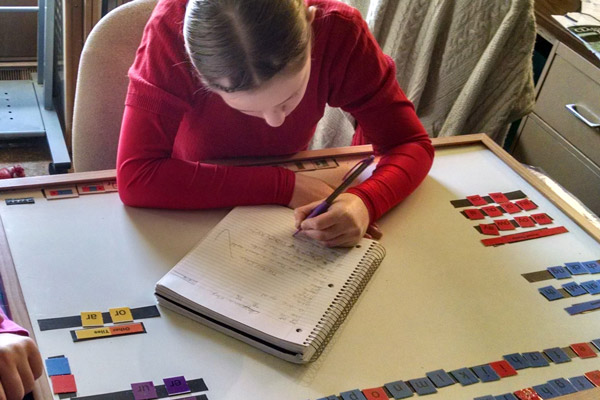
They write their sentences in the notebook, so the words are right there and accessible to them. They can always add extra words to make a good, interesting sentence. I correct the extra words too, especially if they follow a spelling rule that the kids should know.
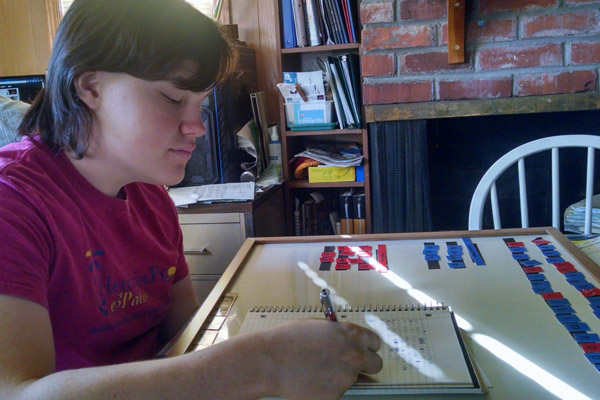
Our cursive practice is always short and sweet, never more than five minutes. We often make silly sentences or stories. This has been a great way for us to squeeze in cursive practice, which had often been shorted before. Plus, this method has provided a practical and painless way to reinforce what my children are learning in spelling.
In the past, my son always said my handwriting just looked like a bunch of squiggles to him, but now he is reading my writing fairly easily. Now that’s progress!
I think the next step may be to ask Dad to write some sentences so they can practice reading other people’s cursive, too.
Here’s What I Loved about Lori’s Story
Lori shared some great tips for combining spelling and cursive writing! Here’s what especially stood out to me:
- She gives “real life meaning” to cursive practice: her children see the practical application of being able to read other people’s handwriting.
- She dovetails spelling and cursive practice.
- They use a timer, and cursive practice takes less than five minutes.
Products Lori has used with her children:
Lori has also found these resources to be helpful:
Did you enjoy Lori’s story? Read more stories in our Real Moms, Real Kids series.
Do you teach cursive writing? If so, what method do you use?
_________________________
*To preserve the privacy of the child featured in this story, we did not use the family’s real names.




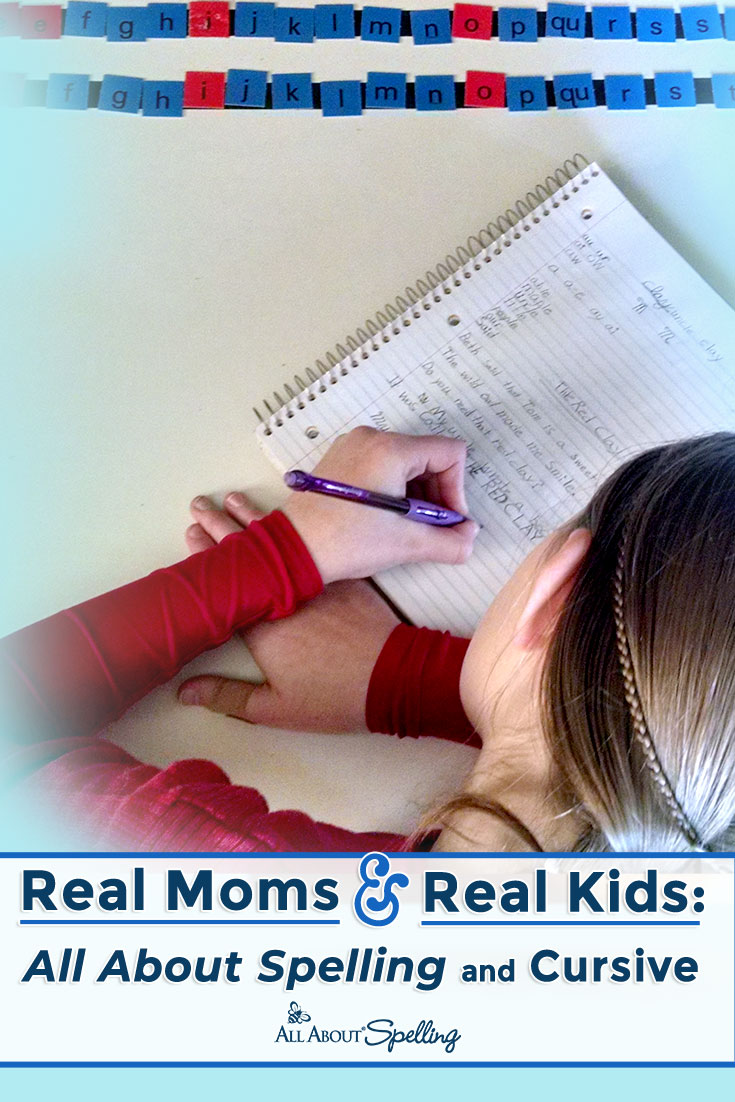





Maria
says:Hi Lori,
I love your idea to combine spelling with cursive practice. I will try to implement the sentence writing activity you describe to one of the students I tutor.
Robin
says: Customer ServiceI’m glad Lori’s approach to spelling and cursive practice will be helpful for your student, Maria!
Natalie
says:My 4th grader has been using Handwriting Without Tears Cursive and D’Nealian for two years. She alternated both between semester 1 and 2. D’Nealian print is a little more difficult, but makes it easier to transition to cursive. I just let my daughter know that the fancy writing was preparing her for cursive, which was even fancier writing. Now she writes cursive in her schoolwork for fun. Can’t wait to incorporate Lori’s method for reading cursive!
Robin E.
says: Customer ServiceThank you for sharing the details of how you have approached handwriting, Natalie! I love Lori’s approach to helping kids gain skill in reading cursive too. I’ve known a few young people that could write cursive, but couldn’t read anyone’s handwriting but their own.
JoAnna
says:Great idea!! Thank you for sharing this.
Robin E.
says: Customer ServiceYou’re welcome, JoAnna!
Teresa
says:This is very timely advice. I have been racking my brain to come up with painless ways to incorporate more cursive practice and reading. Brilliant!
Robin E.
says: Customer ServiceI’m glad this was timely for you, Teresa!
Trinity
says:Hey
Jennifer
says:Thanks for the great idea. My 3rd graders just finished learning all of the letters in cursive and I needed a way now for them to work more with what they’ve learned.
Robin E.
says: Customer ServiceYou are welcome, Jennifer. Using cursive for spelling is a great way to work on both skills as the same time.
Hank Chatman
says:That is such a great idea. I will be doing this for sure!
Kristi F.
says:This mother has wisdom! The progressive steps make this approach to incorporating cursive handwriting seem doable! I’m printing this article to refer back to so that I can implement this style in a way that works for my own students-including an older dyslexic son. Thank you for sharing this story of a “Real Mom!” Please let her know that is has helped another homeschooling family.
Sherry
says:My daughter has just learned to write all of the lower case letters in cursive and it is the one thing she enjoys doing. We simply used a Zaner-Bloser handwriting workbook for 3rd graders. She has beautiful manuscript copywork skills and soon I look forward to seeing copywork in cursive. The trouble is all the detailed copywork doesn’t seemed to have carried over into an understanding of spelling. She will be going into 4th grade this fall and struggled with spelling this list of words after she had worked with them for several days: my (miy), sky (ski), dry (drie), try (triy), cry (criy). She did spell by, fry, mile, nice, and fine correctly, though. She is my fifth child. Her siblings were not amazing spellers, but they were all grade level or above when tested. This is not the case with her. I think she needs the rules that AAS will provide. I like this post’s idea of combining the two and at some point hope to do so.
Robin E.
says: Customer ServiceSherry,
We have a blog post titled Why Copywork Doesn’t Always Work for Teaching Spelling that you might find helpful.
Kristine
says:This is great!! My kids learn Italic and not traditional cursive, but I want them to be able to read cursive. Using your idea I have been writing my own writing station sentence (starts in AAS level 3 I think). in cursive for them to read. After only a week they are able to read most of it. I could not be happier–easy and effective.
Robin E.
says: Customer ServiceKristine,
This is a great adaptation. And yes, Writing Station activities start in AAS 3.
Amy
says:That’s a great idea!
Tonya
says:My second grader wants to learn cursive and I have been trying to figure out how to get started. This is a great idea. Thanks
Darlene
says:Great tips! I’ll try them, thanks!
Arlene Merrick
says:Hello Marie,
I was intrigued to read this particular article because I am teaching my son cursive this year. It has been “A long way baby” for him because we discovered he had disgraphia which the discovery of that was enlightening! It helped us to find the help he needed and through therapies he is now a changed boy in the writing department! A bit behind but at least for the last two years he has been writing and it is legible!! So, this year I introduced cursive and not only was he open to it but has been doing fairly well!! If you knew where he was just three years ago at age 9. You would be shouting from the roof tops as I have with the difference in the past two years. Anyway,all that said. I can appreciate what Lori is doing and it has given me some ideas of being able to eventually do the same and incorporate his All About Spelling words into cursive practice. I love that as a goal to work towards now!!
Robin E. at All About Learning Press
says: Customer ServiceArlene,
It’s so great to hear that your son is having so much success! Thank you for sharing his journey with us.
Lori
says:Arlene, I know what you mean about shouting from the rooftops! My son is not a good speller, but he is SO FAR from where he was 3 years ago! And he now spells more words right than he does wrong. As we progress through the next levels of AAS, I know he is going to be even better.
Something else I have begun doing is this; if they struggle particularly hard over some review words that day, I request they use those words in their cursive sentence for just one more practice that day!
Maureen
says:I’ve been looking for a way to incorporate cursive and I love this idea. Thank you!
Niki P
says:What a great idea! Thanks for sharing.
Janet
says:What a great idea! I struggle, too, with thinking, “How am I going to fit in ONE MORE THING?!” Thanks for sharing your process with this. I’m going to begin this next week when we begin AAS level 5.
Aimee
says:I love this idea! I am going to try it, because even though my children learn to write cursive, they often complain that they can’t read it.
Tara
says:We’ve been using cursive for a few years, now, to help deal with letter reversals. It virtually eliminated them, except for one time when my daughter wrote an entire word in mirror image in cursive. I still have no idea how she managed that!
Robin E. at All About Learning Press
says: Customer ServiceTara,
Did you know that Leonardo Da Vinci could write whole passages in mirror images? Your daughter is in good company!
Liz
says:Lori, I love you you shared how you incrementally increased the difficulty of cursive practice while keeping it short and sweet for your learners. Going from reading your large, careful script on a whiteboard to reading and writing single-spaced sentences in a notebook is commendable progress to make in a year!
Lori
says:When I feel that cursive is automatic enough, I will have them do their dictation sentences in cursive, but we are not there yet. Abby sometimes tries it, but thinking about the cursive detracts from the spelling becoming automatic.
Nina Mills
says:I have a question about your cursive instruction. Did you previously teach them the cursive letters and how to connect the letters? Or was this their first intro into cursive?
If I understand this correctly, your process was , spelling lesson, as far as you got in 20 min. then write a sentence with the spelling words. Then they copied it into cursive. You did the same on the white board, and gradually over time moved to smaller, more natural letters as they demonstrated fluency in reading your and writing. Over time, they skipped printing the sentence and just wrote it out in cursive. Does that sound right? This article is great, short and sweet and you are right, that works well in homeschooling lessons.
Robin E. at All About Learning Press
says: Customer ServiceNina,
I think because Lori’s kids are older (high school and 6th grade), that they had previous cursive instruction. However, I have found that you can teach cursive but if you don’t require your students to use it regularly, and you don’t provide the regular opportunity to read it, that they will never master cursive.
I think it might be easier to use a cursive workbook to teach the letter formation and how to join letters, and then use Lori’s idea to provide regular practice. I like that Handwriting Without Tears stresses short daily practice, not more than the 5 minute or so Lori does.
Lori
says:You’ve got it; summarized the process nicely! This was not teaching cursive; they both had learned cursive, but never used it consistently enough to become fluent. My son, who is dyslexic, never liked cursive and avoids it as much as possible, but he can both read and write it now. (If he must!) My daughter enjoys it. She has some practice sheets from Currclick called A Floral Alphabet that she loves.
Julie
says:Love AAS and AAR
a
says:Good idea. I have one who could use some cursive practice.
Patty Conrad
says:Looks very helpful as we begin cursive.
Steph
says:Great tips! I need to do this to make sure we practice handwriting regularly
Jessica R.
says:Although my son isn’t quite at the point to begin learning cursive, I was unsure if I would teach him cursive at all. This article made me think about how easily cursive handwriting instruction could fit into our homeschool routine and the comments helped me consider some of the benefits of learning cursive today. Thanks for an informative article.
Alison
says:I’m going to have to try this!
Elizabeth m.
says:Love this idea!
Rachel
says:Love this idea! Great way to incorporate cursive into daily work:)